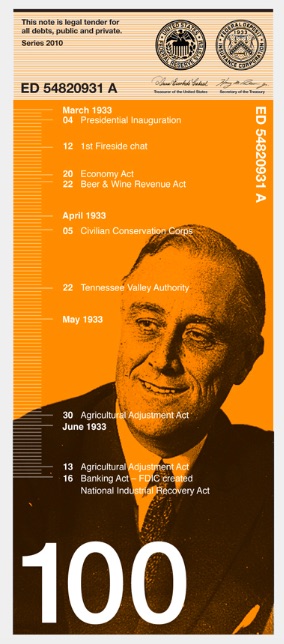If you like little bills, the Malawian kwacha is for you. At 87% the size of the dollar, it is the world’s smallest currency.
Malawian kwaha notes:
Meanwhile, Brunei’s paper currency is 1 1/2 times the size of the dollar. But you don’t need very many of their bills to spend a lot. Two 10,000 Brunei dollar notes will buy you a car. In a briefcase, the equivalent of one million dollars in Brunei’s currency would occupy 1.5% while one million U.S. dollars take up much more room:
So yes, the design of your banknotes matters.
Good Currency Design
The dollar’s design has been called dreadful. The Guardian tells us that, “All the notes look the same from $1 to $20. The money – worn, colourless, often crumpled – has a sort of depressed quality, as if it hasn’t seen the sun much and is suffering a vitamin deficiency.”
The solution could be a vertical dollar. Keeping its width constant, the length and color would change with the denomination. As for the message, maybe a more coherent historical theme?
One of the winning bills for a (privately run) currency redesign project from 2010 uses the denomination to tell a story. Below, we have facts about FDR’s first 100 days on the $100 note:
I know that we are not about to transform the look of our money. However, if we ever did, good currency design involves size, color, functionality, composition, and symbolism:
- Size: Size should vary, depending on denomination.
- Color: Denominations would also have a different color. Then we could easily distinguish them (and not worry about mistakenly giving someone a $10 rather than a $1).
- Functionality: We could do even better. A new $100 bill does have enhanced security. But if texture and size further assisted the visually impaired, we all would benefit.
- Composition: Plastic (polymer) bills would be more durable.
- Symbolism: Our currency could provide a better history lesson.
Our Bottom Line: Characteristics of a Money Supply
Even when currencies are well-designed, they need three basic characteristics to function successfully as money. They must be accepted as a medium of exchange, a yardstick of value and a store of value.
My sources and more: Thanks to the Conversable Economist for alerting me to the IMF report on money around the world. From there, I discovered The Guardian’s criticism of U.S. currency and a WSJ column on the lack of historic consistency for new U.S. $10 and $20 bills. However, if you just go to one source for more, do look at 99% Invisible.
Please note that we copied Our Bottom Line from a past econlife post.








